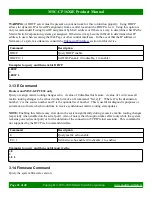
MSC-CP16X4E Product Manual
3.3.2 Command arguments
Command arguments are separated into two categories: numeric and string arguments. These are further
explained in the table below:
Command argument types
Numeric
String
Decimal (123) 1 to 3 decimal digits
Unquoted
Commands with string arguments
automatically interpret argument as
string (spaces and commas not
allowed).
Hex (0x3D)
0xNN where NN are 2 hex digits
from 0-9, A-F or a-f
Double quoted
One or more characters surrounded
by double quotes (“An Argument”).
Single quoted
One or more characters surrounded
by single quotes ('An Argument').
3.4 Response format
Most command responses consist of one or more values separated by newlines and ending with the ‘>’ prompt
character.
Newlines
consist of a Carriage Return/New Line (CR LF) pair of characters (ASCII 13 followed by
ASCII 10).
The Prompt ‘>’
A prompt character ‘>’ is displayed each time a command or chain of commands is entered, to indicate
readiness to receive additional commands. If an error occurs in response to a command, an error will be
displayed prior to the prompt with the following format:
E00: Error message
>
00 will contain a 2 digit decimal error code.
3.5 Command argument values
Command arguments are shown in the Help command output surrounded by square brackets '[ARG]' or
parenthesis '(ARG)'. Square brackets indicate an optional argument and parenthesis indicate a required
argument. Any optional argument specified requires that all prior optional arguments are also specified.
Argument
Valid Range
Meaning
DEST
1-N
Destination number (N = Count of destinations)
SRC
1-N or 0
Source number (N = Count of sources), 0 acts as
mute (if supported).
Page 17 of 48
Copyright © 2013-2015 Matrix Switch Corporation
















































